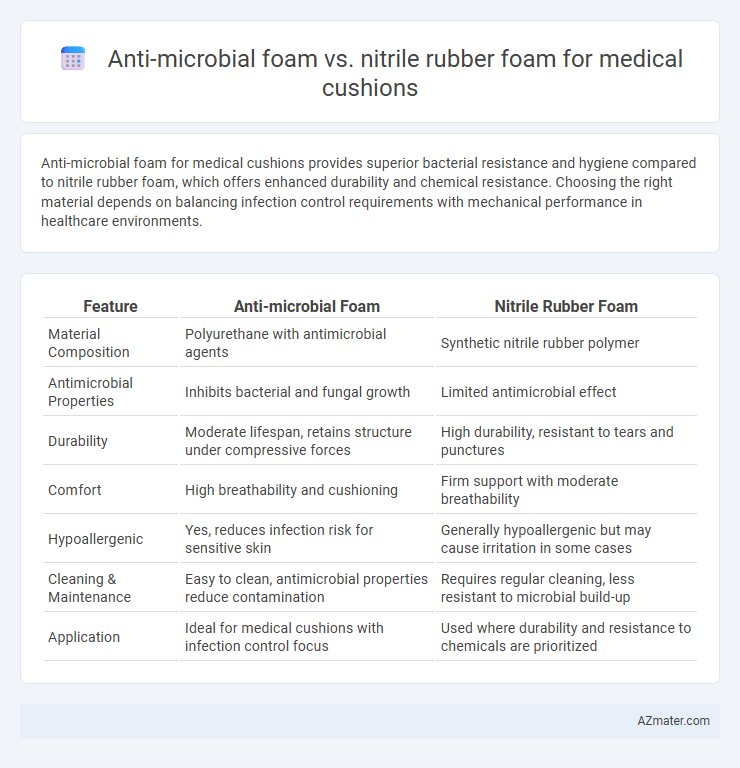Anti-microbial foam for medical cushions provides superior bacterial resistance and hygiene compared to nitrile rubber foam, which offers enhanced durability and chemical resistance. Choosing the right material depends on balancing infection control requirements with mechanical performance in healthcare environments.
Table of Comparison
| Feature | Anti-microbial Foam | Nitrile Rubber Foam |
|---|---|---|
| Material Composition | Polyurethane with antimicrobial agents | Synthetic nitrile rubber polymer |
| Antimicrobial Properties | Inhibits bacterial and fungal growth | Limited antimicrobial effect |
| Durability | Moderate lifespan, retains structure under compressive forces | High durability, resistant to tears and punctures |
| Comfort | High breathability and cushioning | Firm support with moderate breathability |
| Hypoallergenic | Yes, reduces infection risk for sensitive skin | Generally hypoallergenic but may cause irritation in some cases |
| Cleaning & Maintenance | Easy to clean, antimicrobial properties reduce contamination | Requires regular cleaning, less resistant to microbial build-up |
| Application | Ideal for medical cushions with infection control focus | Used where durability and resistance to chemicals are prioritized |
Introduction: Importance of Medical Cushion Materials
Medical cushions require materials with superior antimicrobial properties to prevent infection and promote patient safety in clinical environments. Anti-microbial foam offers enhanced resistance to bacteria and fungi, making it ideal for reducing contamination risks compared to traditional nitrile rubber foam. Selection of the appropriate material directly impacts durability, hygiene, and overall effectiveness in medical applications.
Overview of Anti-Microbial Foam
Anti-microbial foam used in medical cushions is engineered with biocidal agents that inhibit bacteria, fungi, and other pathogens, enhancing infection control in clinical environments. This foam maintains breathability and cushioning properties while providing a hygienic surface that reduces the risk of cross-contamination. Unlike nitrile rubber foam, which emphasizes durability and chemical resistance, anti-microbial foam prioritizes microbial inhibition to support patient safety and comfort.
Understanding Nitrile Rubber Foam
Nitrile rubber foam offers exceptional chemical resistance and durability, making it ideal for medical cushions that require long-term hygiene and comfort. Its closed-cell structure prevents the absorption of fluids and bacteria, enhancing antimicrobial protection without the need for additional coatings. Compared to antimicrobial foam, nitrile rubber foam maintains consistent resilience and support, addressing stringent medical standards for cushioning and patient safety.
Comparative Analysis: Material Composition
Anti-microbial foam used in medical cushions incorporates agents like silver ions or copper compounds that inhibit bacterial growth, enhancing hygiene and patient safety. Nitrile rubber foam, composed primarily of synthetic nitrile butadiene rubber, offers superior resistance to oils, chemicals, and physical abrasion but lacks inherent anti-microbial properties. The choice between these materials depends on the need for microbial protection versus durability and chemical resistance in medical environments.
Anti-Microbial Properties and Infection Control
Anti-microbial foam used in medical cushions incorporates agents like silver ions or copper compounds that actively inhibit bacterial growth, significantly reducing the risk of healthcare-associated infections. Nitrile rubber foam, while durable and resistant to chemicals, lacks inherent anti-microbial properties, making it less effective for infection control in clinical settings. Selecting anti-microbial foam enhances patient safety by minimizing microbial contamination and promoting a sterile environment crucial for wound care and prolonged patient contact.
Durability and Longevity in Medical Environments
Anti-microbial foam demonstrates superior resistance to microbial growth, ensuring enhanced hygiene and extended durability in medical environments compared to nitrile rubber foam. Nitrile rubber foam offers excellent mechanical strength and chemical resistance but may degrade faster under continuous exposure to disinfectants and bodily fluids. The longevity of medical cushions relies heavily on anti-microbial properties combined with material resilience, positioning anti-microbial foam as a more durable solution for long-term use in healthcare settings.
Comfort and Pressure Relief for Patients
Anti-microbial foam for medical cushions offers superior infection control and breathability, enhancing patient comfort by reducing moisture buildup and odor. Nitrile rubber foam excels in pressure relief due to its high resilience and durability, providing consistent support and preventing pressure ulcers in prolonged use. Balancing anti-microbial properties with effective pressure distribution is essential for optimizing patient comfort and skin integrity in clinical settings.
Cleaning, Maintenance, and Hygiene Standards
Anti-microbial foam used in medical cushions offers superior resistance to bacterial growth, simplifying cleaning processes and ensuring higher hygiene standards compared to nitrile rubber foam. Nitrile rubber foam, while durable and resistant to oils and chemicals, requires more frequent and intensive maintenance to prevent microbial contamination. Both materials must adhere to medical hygiene protocols, but anti-microbial foam significantly reduces the risk of infection and cross-contamination during routine cleaning and upkeep.
Cost-Effectiveness and Sustainability
Anti-microbial foam offers enhanced hygiene and infection control, making it ideal for medical cushions while being cost-effective due to reduced replacement frequency. Nitrile rubber foam provides excellent durability and resistance to chemicals, supporting long-term use and sustainability by minimizing material waste. Balancing initial cost, lifespan, and environmental impact, anti-microbial foam often leads to lower overall expenses, whereas nitrile rubber foam excels in eco-friendly recycling and resilience.
Conclusion: Selecting the Optimal Foam for Medical Cushions
Anti-microbial foam offers superior resistance to bacterial growth, enhancing hygiene and patient safety in medical cushions, while nitrile rubber foam provides excellent durability and chemical resistance, suitable for high-wear environments. Selecting the optimal foam depends on prioritizing either infection control or mechanical resilience within the specific medical application. Balancing antimicrobial properties with material robustness ensures the best performance and longevity in medical cushion usage.

Infographic: Anti-microbial foam vs Nitrile Rubber foam for Medical Cushion
 azmater.com
azmater.com